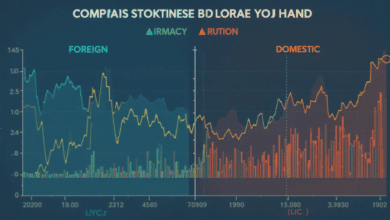NSE FII DII Data: A Complete Guide to Institutional Investments in Indian Stock Market

NSE FII DII data represents daily trading activity by Foreign Institutional Investors (FIIs) and Domestic Institutional Investors (DIIs) on the National Stock Exchange (NSE) in India. This data is crucial as it indicates the level of investment and confidence these institutions hold in Indian markets. FIIs refer to foreign entities that invest in Indian markets, while DIIs represent domestic entities, including mutual funds, insurance companies, and banks.
Analyzing NSE FII DII data gives investors insights into market trends, helping them make informed decisions. FIIs, with their global outlook, and DIIs, with their understanding of domestic markets, have a major impact on stock prices, volatility, and market trends. Understanding this data allows investors to gauge market sentiment and potential trends, especially as institutional investors are known to shape market movements.
The Role of Foreign Institutional Investors (FIIs) in NSE FII DII Data
Foreign Institutional Investors (FIIs) are entities like hedge funds, mutual funds, and investment banks based outside India, investing in Indian assets. Their investments in stocks, bonds, and other securities in India make them a significant force on the NSE. FIIs bring foreign capital, diversify the market, and often influence stocks due to their substantial buying and selling activities.
NSE FII DII data highlights how FIIs approach Indian markets, as they often react to global trends, interest rates, and policies. When FIIs invest heavily, it signals positive sentiment toward India’s economy, and vice versa. Monitoring this data helps investors understand how FIIs’ strategies impact stock prices, allowing them to align their investments accordingly.
Understanding Domestic Institutional Investors (DIIs) in NSE FII DII Data
Domestic Institutional Investors (DIIs) represent entities within India, like mutual funds, insurance companies, and government bodies, that invest in financial markets. They play a stabilizing role in the NSE as they are less influenced by global fluctuations than FIIs, focusing on the country’s economic stability and growth.
DIIs provide valuable insights into how domestic market sentiment is shaping up. Unlike FIIs, who may withdraw during global uncertainties, DIIs typically stay invested, maintaining market balance. Tracking NSE FII DII data for DIIs helps investors understand domestic sentiment and stability, especially during periods of market volatility.
How to Access and Interpret NSE FII DII Data
NSE FII DII data is available on financial news websites, stock exchanges, and investment platforms. To access it, investors can visit the NSE’s official website or other reliable platforms offering daily FII and DII data. The data typically includes net purchases, sales, and total investment volumes.
Interpreting this data involves looking at net investments—whether FIIs and DIIs are net buyers or sellers on a given day. Consistent buying by FIIs may indicate a bullish trend, while selling could signal a bearish outlook. By studying this data over time, investors can identify patterns and gauge future market movements, helping them make more informed investment decisions.
Impact of FII and DII Activity on Stock Market Movements
NSE FII DII data profoundly impacts stock market trends, as FIIs and DIIs influence liquidity, volatility, and pricing. When FIIs buy in large volumes, stock prices often rise due to increased demand, while heavy selling can lead to declines. DIIs, conversely, are stabilizers, buying when FIIs sell to avoid extreme market fluctuations.
For retail investors, tracking this data offers a way to predict market direction. For example, if both FIIs and DIIs are buying, it suggests strong confidence, while selling from both may indicate uncertainty. Understanding the combined effect of FIIs and DIIs helps investors align their strategies with the broader market direction.
Analyzing Trends and Patterns in NSE FII DII Data
Analyzing trends in NSE FII DII data reveals the underlying sentiment in the market. Consistent buying by FIIs often correlates with an appreciating market, while continuous selling can signal bearish trends. Investors often use this data to identify long-term patterns and trends that may affect individual stocks and the broader market.
Examining monthly, quarterly, or annual trends in FII and DII activity can reveal important shifts in sentiment. For instance, a sustained increase in DII investments might signal that domestic players are confident in economic growth, even if FIIs are cautious. These insights enable investors to spot opportunities and make decisions that align with market conditions.
Using NSE FII DII Data to Make Investment Decisions
NSE FII DII data can guide investors in formulating their trading strategies. By monitoring the net purchases or sales of FIIs and DIIs, retail investors gain insight into market sentiment, helping them decide when to buy, hold, or sell. For example, if FIIs are consistently buying, it could signal a favorable time to invest.
Long-term investors use this data to assess market health, while short-term traders may leverage it to time their trades based on FII or DII activity. Whether investors prefer a bullish or bearish approach, tracking NSE FII DII data can enhance their strategy by revealing the positioning of major players in the market.
The Influence of Global Events on NSE FII DII Data
Global events, such as geopolitical tensions, monetary policies, or international market trends, influence NSE FII DII data, especially on the FII side. Since FIIs operate with a global perspective, events like U.S. interest rate changes or trade agreements can impact their investment choices in India.
For instance, an increase in U.S. interest rates may lead FIIs to pull out investments from emerging markets, affecting NSE FII DII data. Investors need to consider these factors while analyzing FII DII trends. By understanding the relationship between global events and FII/DII activity, investors can better anticipate changes in the Indian stock market.
NSE FII DII Data: Historical Analysis and Long-Term Trends
Studying the historical patterns of NSE FII DII data can reveal long-term trends that shape the Indian stock market. Over time, FIIs have played a pivotal role in driving market rallies, while DIIs have maintained stability. Analyzing these trends provides insights into how past economic cycles and policy changes influenced FII and DII behavior.
Investors can use historical NSE FII DII data to compare different economic phases and predict future market directions. For instance, if previous economic recoveries were marked by significant FII inflows, a similar pattern could be expected in future recoveries. This analysis equips investors to anticipate shifts in the market based on institutional behavior.
Conclusion
NSE FII DII data is an essential tool for investors seeking to understand the pulse of the Indian stock market. By examining the trading activities of FIIs and DIIs, investors can gain insights into market sentiment, potential price movements, and the effects of both global and domestic factors on the market. FIIs bring a global perspective, while DIIs provide stability and support during market fluctuations.
Using NSE FII DII data to shape investment decisions helps investors time their entries and exits more effectively, improving their chances of favorable outcomes. Whether through historical trends, daily analysis, or patterns shaped by global events, this data enables investors to make well-informed decisions in an ever-changing market environment.
FAQs
Q1: Where can I find NSE FII DII data?
A: NSE FII DII data is available on the National Stock Exchange’s website and other reliable financial news platforms. This data provides daily updates on FII and DII investment activity.
Q2: How do FIIs and DIIs impact stock market trends?
A: FIIs influence market liquidity and trends with substantial foreign investment, while DIIs provide stability and often balance out FII movements, helping to reduce volatility.
Q3: Can NSE FII DII data predict market movements?
A: While not a guaranteed prediction tool, analyzing FII and DII trends can give insights into market sentiment, helping investors anticipate potential price movements.
Q4: How do global events affect NSE FII DII data?
A: Global events like interest rate changes and political tensions influence FII decisions, often affecting the NSE FII DII data due to FIIs’ global investment perspectives.
Q5: Is NSE FII DII data helpful for short-term trading?
A: Yes, short-term traders use FII DII data to time their trades based on market sentiment, though it’s often combined with other indicators for accuracy.





